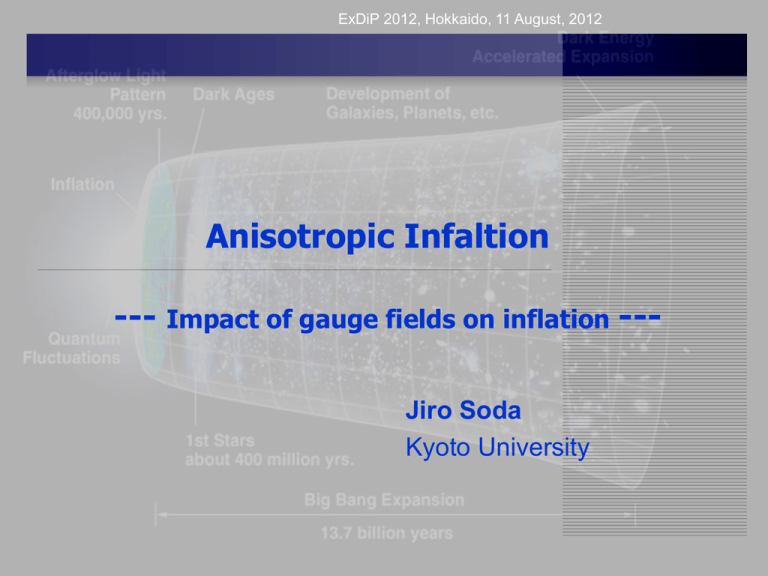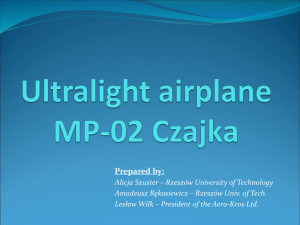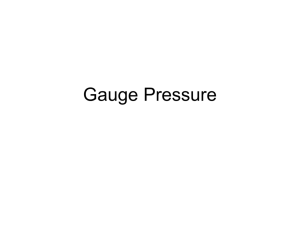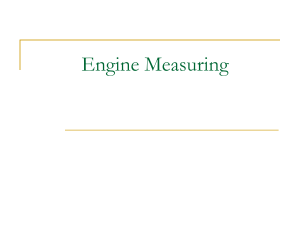Anisotropic inflation
advertisement

ExDiP 2012, Hokkaido, 11 August, 2012
Anisotropic Infaltion
--- Impact of gauge fields on inflation --Jiro Soda
Kyoto University
Standard isotropic inflation
Action
S
M p2
1
4
4
d
x
g
R
d
x
g
V
(
)
2
2
K-G eq.
H2
1
3M p2
1/ 2
2.4 1018 GeV
ds 2 dt 2 a 2 (t ) dx 2 dy 2 dz 2
Isotropic homogeneous universe
Friedman eq.
M p 8 G
1 2
V
(
)
2
H
a
a
3H V '( ) 0
inflation
a eH t
2
Origin of fluctuations
Curvature perturbations
H 2
Rc N H t H
2
H4
1 H2
Ps
4 2 8 2 M p2
Rc ( x1 )
inflation
end 1
Rc ( x2 )
一定
scale invariant spectrum
N ( x1 )
Action for GW
The relation
S
M p2
8
4
ij
ij
d
x
h
h
h
h
ij
ij
M pl h / 2
Tensor perturbations
The tensor to the scalar ratio
yields
h
( x1 )
N ( x2 )
( x2 )
initial
H
M pl
2 H2
Pt 2 2
Mp
2 polarizations
P
8 d
r t 16 2
Ps
M p dN
2
3
From COBE to WMAP!
gravitational red shift
T
T
T
T
:
CMB angular power spectrum
a mY m ,
a ma ' m' C 'mm'
m
The predictions have been proved
by cosmological observations.
COBE
WMAP provided more precise data!
We now need to look at a percent level fine structure of primordial fluctuations!
4
Primordial gravitational waves via B-modes
E and B Polarizations
Primordial gravitational waves
Statistical Anisotropy?
Eriksen et al. 2004
Hansen et al. 2009
2
P (k ) P0 (k ) 1 g ( k ) k n
n
: prefered direction
Groeneboomn & Eriksen (2008)
The preferred direction may be produced by gauge fields.
6
What should we look at?
There are two directions in studying fine structures of fluctuations!
quantitative improvement
qualitative improvement
-> spectral tilt
-> non-Gaussianity
PGW
Yet other possibility is
the statistical anisotropy
If there exists coherent gauge fields during inflation,
the expansion of the universe must be anisotropic.
Thus, we may have statistical anisotropy in the primordial fluctuations.
7
Gauge fields and cosmic no-hair
8
The anomaly suggests gauge fields?
gauge fields
FLRW universe
S
1
d 4 x g g g F F
4
ds 2 dt 2 a 2 (t) dx 2 dy 2 dz 2 a 2 ( ) d 2 dx 2 dy 2 dz 2
The key feature of gauge fields is the conformal invariance.
In terms of a conformal time, we can explicitly see the conformal invariance
S
1 4 4 1
1
d
x
a
(
)
F
F
2
2
4
a ( ) a ( )
cancelled out
Thus, gauge fields are decoupled from the cosmic expansion
and hence no interesting effect can be expected.
In particular, gauge fields are never generated during inflation.
However, …..
9
Gauge fields in supergravity
Supergravity action
S d 4 x g R gi j i j e
2
K ( )
g i j DiW ( )D jW ( ) 3 2 W ( )
2
1
1
d 4 x g Re f ab ( i )F a Fb Im f ab ( i ) Fa Fb
8
4
K ( ) : Kahler potential
W ( ) : superpotential
fab ( ) : gauge kinetic function
Cosmological roles of Kahler potential and super potential in inflation has been well discussed so far.
While, the role of gauge kinetic function in inflation has been overlooked.
The non-trivial gauge coupling breaks the conformal invariance
because the scalar field has no conformal invariance.
Thus, there is a chance for gauge fields to make inflation anisotropic.
Why, no one investigated this possibility?
10
Black hole no-hair theorem
Israel 1967,Carter 1970, Hawking 1972
Let me start with analogy between black holes and cosmology.
any initial configurations
Black hole has no hair other than M,J,Q
J
Q
M
gravitational collapse
event horizon
By analogy, we also expect the no-hair theorem for cosmological event horizons.
11
Cosmic no-hair conjecture
cosmic expansion
Gibbons & Hawking 1977, Hawking & Moss 1982
deSitter
Inhomogeneous and
anisotropic universe
T
T
no-hair?
12
Cosmic No-hair Theorem
Wald (1983)
Statement:
The universe of Bianchi Type I ~ VIII will be isotropized and evolves toward
de Sitter space-time, provided there is a positive cosmological constant .
Assumption:
, p : energy density & pressure other than cosmological constant
Dominant energy condition: ex)
Strong energy condition: ex)
Type IX needs a caveat.
0
3p 0
p
p0
Sketch of the proof
Ricci tensor (0,0)
ds2 dt 2 hij ( x )dx dx
K 1 2
1
1
K ij ij 2 T g T t t
t 3
2
Mp
0
Einstein equation (0,0)
1 2
K
3
1
1 i j 1 (3)
R
T
t
t
j i
2
2
Mp
2
Bianchi Type I ~ VIII :
0
Strong Energy Condition
Dominant Energy Condition
R0
3 K
K 3 in time scale :
ij 0
t
3
tanh
3
t
3
No Shear = Isotropized
(3)
T00 0
1
1
hij K ij K ij ij
2 t
3
(3)
K
1
K2 0
t
3
R0
ij0
in time scale :
t
3
Spatially Flat
No matter
14
The cosmic no-hair conjecture kills gauge fields!
Since the potential energy of a scalar field can mimic a cosmological constant,
we can expect the cosmic no-hair can be applicable to inflating universe.
Inflationary universe
T
T
Initial gauge fields
No gauge fields!
Any preexistent gauge fields will disappear during inflation.
Actually, inflation erases any initial memory other than quantum vacuum fluctuations.
Predictability is high!
15
Can we evade the cosmic no-hair conjecture?
One may expect that violation of energy conditions makes inflation anisotropic.
・Vector inflation with vector potential
Ford (1989)
1
L F F V ( A A )
F A A
4
・・・Fine tuning of the potential is necessary.
・Lorentz violation
1
L F F ( A A m 2 )
4
Ackerman et al. (2007)
・・・Vector field is spacelike but A0 0 is necessary.
・A nonminimal coupling of vector to scalar curvature
1
1
1
L Fi F i m2 R Ai Ai
4
2
6
Golovnev et al. (2008), Kanno et al. (2008)
・・・More than 3 vectors or inflaton is required
All of these models breaking the energy condition
have ghost instabilities.
Himmetoglu et al. (2009)
Anisotropic inflation
17
Gauge fields in inflationary background
de Sitter background
abelian gauge fields
ds2 dt 2 a 2 (t) dx 2 dy 2 dz 2
S
1 4
d x g f 2 (a) F F
4
a () dt
2
2
dx 2 dy 2 dz 2
F A A
a( ) e Ht
1
H
f depends on time.
f ( (t))
gauge symmetry
A A
It is possible to take the gauge A0 0 , i Ai 0
d 3k
ikx
Ai
3/2 Ak ( ) i (k)e
2
ki i (k) 0, i (k)i ' (k) '
Ak ( ) Ak ( )
A 2
1
4
2
1 4
k 2 Ak ( ) Ak ( )
S d x g f 2 i Ai 2i Ai 2 d x g f
2
canonical commutation relation
Ak , k' ' i ' (k k')
k
S
Ak /
f 2 Ak
18
Do gauge fields survive?
2 uk
1 f uk
2
k 2 uk 0
2
f
†
†
Ak uk ()ak uk* ()ak
Ak
Canonical commutation relation leads to commutation relations and the normalization
uk*
u
i
uk
uk* k 2
f
ak , ak' ' k k'
vacuum
'†
ak 0 0
Thus, it is easy to obtain power spectrums
dk
0 Ai (x)A (0) 0 PA (k)eikx
k
i
P(k)
blue
k 3 u ()
PA (k) 2 k2
a ()
2
The blue spectrum means
no gauge fields remain during inflation.
The red spectrum means
gauge fields survive during inflation.
red
k
19
Mode functions on super-horizon scales
2 vk 2 1 2 f
k
vk 0
2
f 2
vk f uk
sub-horizon
k
Take a parametrization
a
f
af
ii) c
1
4
uk
1
eik
f 2k
2 uk
1 f uk
2
0
2
f
2 uk
f
0
uk c1 c%
2
d
f2
2c
1
d
da d
Ha 2 d
H H 2
matching at the horizon crossing
1
i) c
4
1 ik
e
2k
k 0
super-horizon
Since we know
vk
ak H k
1
c2 ak4 c1
fk 2k
we get
uk c1 c%
2
da
c1 c2 a 4 c1
2 2
Ha f
Length
Super-horizon
a
k
1
c1
fk 2k
H 1
Sub-horizon
time
20
Gauge fields survive!
Finally, at the end of inflation, we obtain the power spectrum of gauge fields on super-horizon scales
i) c
1
4
1
uk
fk 2k
k 3 uk ( f )
af
a
k
4 c 1
2
H Ha f
PA (k) 2 2
a ( f )
2 k
ii) c
1
4
uk
2c 2
c 1
red spectrum
1
fk 2k
k 3 uk ( )
H Ha f
PA (k) 2 2
a ( )
2 k
2
2c1
c
1
2
red spectrum
For a large parameter region, we have a red spectrum,
which means that there exists coherent long wavelength gauge fields!
21
We should overcome prejudice!
According to the cosmic no-hair conjecture,
the inflation should be isotropic and no gauge fields survive during inflation.
However, we have shown that gauge fields can survive during inflation.
It implies that the cosmic no-hair conjecture does not necessarily hold in inflation.
Hence, there may exist anisotropic inflation.
22
Gauge fields and backreaction
power-law inflation
M p2
2
1
S d x g
R V ( )
2
2
4
V V0 e
Mp
In this case, it is well known that there exists an isotropic power law inflation
ds 2 dt 2 t 4/ dx 2 dy 2 dz 2
2
Mp
2
logt
In this background, one can consider generation of gauge fields
M p2
2
1
1
S d x g
R V ( ) f 2 ( ) F F
2
4
2
4
our universe
gauge kinetic function
f f 0e
Mp
There appear coherent gauge fields in each Hubble volume.
Thus, we need to consider backreaction of gauge fields.
H 1
23
Watanabe, Kanno, Soda, PRL, 2009
Exact Anisotropic inflation
Kanno, Watanabe, Soda, JCAP, 2010
For homogeneous background, the time component can be eliminated by gauge transformation.
Let the direction of the vector to be x – axis.
A 0, A (t), 0, 0
x
2 2 4 0, we found the following new solution
Mp
ds2 dt 2 e2 (t ) e4 (t ) dx 2 e2 (t ) dy 2 dz 2
ds2 dt 2 t 2 t 4 dx 2 t 2 dy 2 dz 2
Then, the metric should be Bianchi Type-I
For the parameter region
2
logt
Ax (t) Ct
2 8 12 2 8
6 2
4
2 2 4
3 2
4
Apparently, the expansion is anisotropic and its degree of anisotropy is given by
& 1
I
H & 3 H
2 2 4
I
2 2
0 I 1
H
6 2
H&
H 2 2 8 12 2 8
slow roll parameter
24
The phase space structure
Kanno, Watanabe, Soda, JCAP, 2010
Quantum fluctuations generate seeds of coherent vector fields.
2 2 4 0
vector
Anisotropic inflation
scalar
Isotropic inflation
anisotropy
After a transient isotropic inflationary phase,
the universe enter into an anisotropic inflationary phase.
The result universally holds for other set of potential and gauge kinetic functions.
25
More general cases
Hamiltonian Constraint
Mp 1
t
1 1 &2
E 2 2
4 4
& & V ( )
f ( )e
32
2
2
2
Scale factor
2
E
&& 3&2 V ( )
f 2 ( )e4 4
6
Anisotropy
E 2 2
&& 3&&
f ( )e4 4
3
Scalar field '
3 V ( ) E 2 f 3 ( ) f ( )e4 4
ds 2 dt 2 e2 (t ) e4 (t ) dx 2 e2 (t ) dy 2 dz 2
A (0, v(t), 0 , 0 )
(t )
v f 2 ( )e 4 E
const. of integration
Behavior of the vector is determined by the coupling
Hamiltonian Constraint
2
1
E
1
2
f 2 ( )e4 4
&2 2 V ( )
2
3 2
Scalar field
Conventional slow-roll equations
(The 1st Inflationary Phase)
d &
V ( )
d &
V ( )
3 V ( ) E 2 f 3 ( ) f ( )e4 4
V
d
V
Now we can determine the functional form of f
f ( ) e
2
2
e
m2 2
V
2
V
V d
Critical Case
2 2
f e
f ( ) e2
To go beyond the critical case, we generalize the function by introducing a parameter
c 2 2
f e
c
1 Vector grows
1 Vector remains const.
1 Vector is negligible
The vector field should grow
in the 1st inflationary phase.
Can we expect that the vector field would keep growing forever?
Attractor mechanism
Hamiltonian Constraint
1
3
2
&2
2
1 &2 m 2 E 2 c 2 4 4
e
2
2
2
Scalar field
e
2
2 2
e
3 m cE e
2
c2 4 4
2
The opposite force to the mass term
Define the ratio of the energy density
A E e
R
m2 2
c 1
2 c 2 4
e4( c 1)
The growth should be saturated around
Typically, inflation takes place at
cE 2ec
O (10)
Irrespective of initial conditions, we have
R=
102
2
4
m2
1
R 2
c
102
Inflaton dynamics in the attractor phase
The modified slow-roll equations: The second inflationary phase
Hamiltonian Constraint
1
6
&2 m2 2
d
2cE 2 c 2 4
2 2 e
d
m
Scalar field
Energy Density
2
2 c 2 2 4
&
&
3 m c E e
E 2 c 2 4
A
e
2
Remember
c 1
Solvable
e
c 2 4
m (c 1)
4( c 1)
De
1
c2 E 2
2
1
m2 (c 1)
2c 2
const. of integration
We find A becomes constant during the second inflationary phase.
m2
E.O.M. for Φ : 3
c
3 m2
(2nd inflationary phase)
(1st inflationary phase)
1
c
Phase flow: Inflaton
Scalar field
3 m2
(1st inflationary phase)
2
m
3
(2nd inflationary phase)
Numerically solution at
c
c2
m 105
1
2
c0 17
The degree of Anisotropy
Ratio
Anisotropy
A E e
R
m2 2
Attractor Point
2 c 2 4
2
E c
3&&
e
3
2
4 4
The degree of anisotropy is determined by
& E 2ec 4
H &
9&2
2
Attractor point
2
R (t )
3
3&2
e
c 2 4
m2 (c 1)
c2 E 2
2
2 c 1
R (t)
H 3
3 c2 2
1 2 2
m :Hamiltonian Constraint
2
The slow-roll parameter is given by
2
Attractor point
2
c 2
Compare
We find that the degree of anisotropy is written by the slow-roll parameter.
1 c 1
H 3 c
: A universal relation
Evolutions of the degree of anisotropy
Numerically solution at
c0 17
= R (t ) A
H
becomes constant
H
0.3%
disappears
x
grows fast
increase
Initially negligible
32
Anisotropic Inflation is an attractor
ds2 dt 2 e2 Ht e4 t dx 2 e2 t dy 2 dz 2
1
I H
H 3
0 I 1
It is true that exponential expansion erases any initial memory.
In this sense, we have still the predictability.
However, the gauge kinetic function generates a slight anisotropy in spacetime.
Statistical Symmetry Breaking in the CMB
33
Phenomenology of anisotropic inflation
34
What can we expect for CMB observables?
In the isotropic inflation, scalar, vector, tensor perturbations are decoupled.
The power spectrum is isotropic
(k1 ) (k 2 ) (k1 k 2 )Ps (k1 | k1 |)
h(k1 )h(k 2 ) (k1 k 2 )Pt (k1 | k1 |)
However, in anisotropic inflation, we have the following couplings
vector-scalar
g g g
{f ( ) {F F
ff
1
f2
em n
em I H
f
V
1
f V
H
f
f
length
2
em
1
H
I H I
Preferred direction
n A
a
k
H 1
N (k)
t
vector-tensor
g g g f 2 ( )F F
14 2 43
em n
em I H
35
Predictions of anisotropic inflation
Thus, we found the following nature of primodordial fluctuations in anisotropic inflation.
Watanabe, Kanno, Soda, PTP, 2010
Dulaney, Gresham, PRD, 2010
Gumrukcuoglu,, Himmetoglu., Peloso PRD, 2010
statistical anisotropy in curvature perturbations
2
Ps (k) Ps (k) 1 g s n kö
gs 24 I N 2 (k )
n
statistical anisotropy in primordial GWs
Pt (k) Pt (k) 1 gt n kö
2
preferred
direction
gt 6 I H N 2 (k )
kˆ
cross correlation between curvature perturbations and primordial GWs
rc
G
24 I H N 2 (k )
TB correlation in CMB
These results give consistency relations between observables.
64gt r gs
rc 4 gt
36
How to test the anisotropic inflation?
The current observational constraint is given by
WMAP constraint
Pullen & Kamionkowski 2007
Now, suppose we detected
gs 24 I N 2 (k ) 0.3
gs 24 I N 2 (k ) 0.3 H 0.02
Then we could expect
• statistical anisotropy in GWs
gt 1.5 103
• cross correlation between curvature perturbations and GWs
G
6 103
If these predictions are proved, it must be an evidence of anisotropic inflation!
37
How does the anisotropy appear in the CMB spectrum?
Angular power spectrum of X and Y reads
C XY d k PXY k sY *m kˆ
For isotropic spectrum,
P k P k
Y m kˆ
s
C XY
, we have
For anisotropic spectrum, there are off-diagonal components.
For example,
C TB d k PTB k Y *m kˆ
Y m kˆ
2
, 1
The off-diagonal part of the angular power spectrum tells us
if the gauge kinetic function plays a role in inflation.
38
We should look for the following signals in PLANCK data!
When we assume the tensor to the scalar ratio
r 0.3
and scalar anisotropy
gs 0.3
The off-diagonal spectrum becomes
Watanabe, Kanno, Soda, MNRAS Letters, 2011
The anisotropic inflation can be tested through the CMB observation!
39
Non-gaussianity in isotropic inflation
2
1
1
1
S d 4 x g R V ( ) f 2 ( ) F F
2
4
2
f ( ) e
c 2
2
e2c a( )2c
deSitter
k 3 uk ( )
H Ha f
PA (k) 2 2
a ( )
2 k
2
a( )
1
H
2c2
For c=1, we have the scale invariant spectrum.
2
P P 1192 P NCMB
(Ntot NCMB ) : P
3
f NLlocal 1280PNCMB
(Ntot NCMB ) : 102 (Ntot NCMB ) 600
k13k33 k1 k2 k3 1 cos2 ( kˆ1 kˆ3 ) cosY00 sinY20
anisotropy
Barnaby, Namba, Peloso 2012
; 0.22
Non-gaussianity in anisotropic inflation
c 1
1
6
&2 m2 2
2
d
2 2c
2 E 2 ec 4
d
m
3&& m2 c E 2ec 4
2
f ( ) e
Scale invariant
ceff 1
c 2
2
e2 a( )2
Is an attractor!
e
c 2
c2 E 2
2
e4
m (c 1)
Summary
Anisotropic inflation can be realized in the context of supergravity.
As a by-product, we found a counter example to the cosmic no-hair conjecture.
We have shown that anisotropic inflation with a gauge kinetic function
induces the statistical symmetry breaking in the CMB.
More precisely, we have given the predictions:
the statistical anisotropy in scalar and tensor fluctuations
the cross correlation between scalar and tensor
the sizable non-gaussianity
Off-diagonal angular power spectrum can be used to prove or disprove our scenario.
We have already given a first cosmological constraint on gauge kinetic functions.
gs 24 I N (k) 0.3
2
2 2 4
0.3
I
2 2
24 N 2 (k)
42








